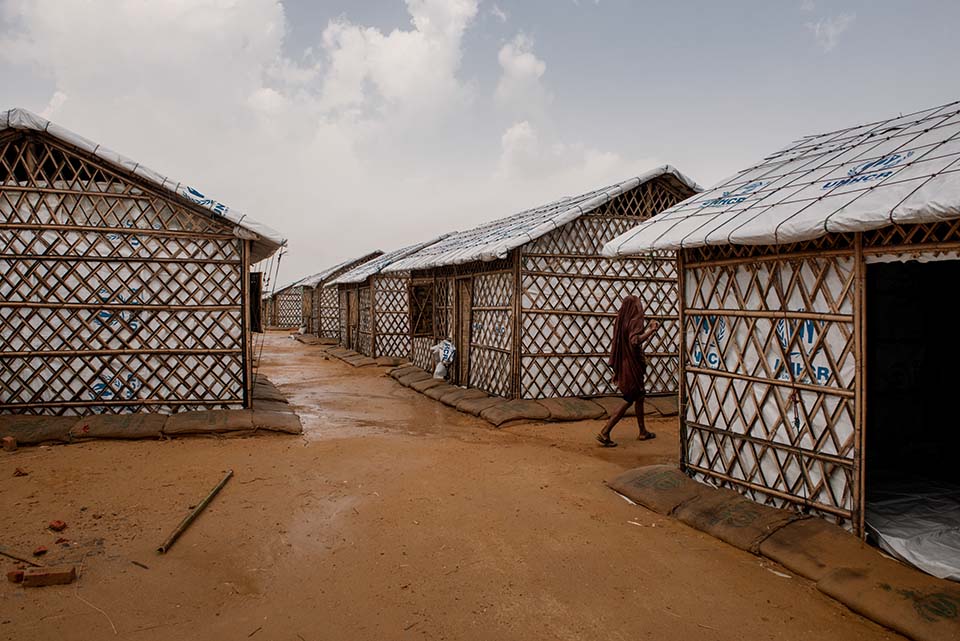

Rohingya Refugees Build Homes and Communities Amid Crisis
In times of crisis, forced to flee all they know just to save themselves and their families, people can lose so much. But the first step in rebuilding is having a roof over one’s head and a chance to rest in safety. When a home is destroyed, dreams are lost too. A new home is a chance to start dreaming again. It is more than just a building—a home is hope that life will go on after tragedy.
In Search of Home
Over a million Rohingya refugees flooded into Bangladesh in 2018, fleeing persecution in neighboring Myanmar. They took up residence on unstable coastal hillsides, where they became vulnerable to new risks from climate change. Bangladesh has already seen its own citizens internally displaced by climate catastrophes. The tarp tents did little to protect residents from frequent monsoons and heavy winds.
“The land is a concern. If there is heavy rain, there is the potential threat for landslides and floods,” says Caritas Bangladesh executive director Francis Atul Sarker. “The whole hill can melt like ice cream, creating havoc within disaster.”
In collaboration with our Caritas partners, CRS is helping Rohingya refugees transition to sturdier shelters where they can access services necessary to begin the process of healing and rebuilding their lives.

“For us, community building—the sense of helping each other—is the most important,” Caritas Bangladesh executive director Francis Atul Sarker says.
Photo by Ismail Ferdous for CRS
CRS views shelter programming from a perspective of integral human development—the physical, spiritual, mental and emotional aspects of rebuilding a home.
“For us, community building—the sense of helping each other—is the most important,” Francis says. Many refugees are not simply provided a new shelter. They are given shelter kits and taught to construct homes for themselves or their vulnerable neighbors.

CRS is assisting Caritas Bangladesh in providing 265,636 Rohingya refugees with comprehensive support including new, safe and dignified shelters that they construct themselves.
Photo by Ismail Ferdous for CRS
Building a Better Life for His Neighbors
Hamidullah, a Rohingya refugee, works with CRS to construct new shelters for his fellow refugees.
“I’m thankful Caritas created this work opportunity for Rohingyas. I use the money I earn to buy groceries and treatment for my children,” he says. Hamidullah arrived in Bangladesh after, he says, government forces burned his home down and assaulted women in his family.
“I hope for justice in my country,” he says. But until it is safe to return home, he is grateful to be working to create for a better life for his family and his fellow Rohingya brothers and sisters. “These houses are much better than the previous houses. The kids can play here.”

Hamidullah is a Rohingya refugee who works with CRS and Caritas to construct safe and durable shelters for his family and the families of his fellow refugees.
Photo by Ismail Ferdous for CRS
Ziabur Rahman, whose wife was nine months pregnant, expressed his gratitude for the upgraded shelter.
“I was there in a landslide. My house collapsed from rain. I could have died but by the blessing of God I am here.” He hopes to bring his child into a safer world. “We came here looking for peace. I am so pleased to see this new house.”
Along with construction of sturdier housing and some relocations, Caritas is preparing existing camps for a future of extreme weather. Newly planted trees will prevent soil erosion that leads to landslides. Dirt pathways and staircases have been reinforced to prevent wash-out. Drainage systems have been implemented to direct floodwaters away from homes.

The planned camp addresses overcrowding issues, makes living conditions safer and more hygienic for families, and includes gender-segregated toilets and bathing facilities.
Photo by Ismail Ferdous for CRS
For many Caritas staff, this work is a calling. They themselves have walked in the shoes of refugees. Executive Director Francis Atul Sarker fled Pakistan on foot when he was just 12 years old. These experiences inform the role of empathy in their work. “God has blessed me,” he says. “For me to be a refugee at that tender age, God was preparing my heart to take care of the people.”
“They have lost so many people. They thought they had no one, now they feel they have friends and can better understand the camp and the advice they receive,” says Nasrin Jhorna, a facilitator in one of the child-friendly spaces. Photo by Ismail Ferdous for CRS

“They have lost so many people. They thought they had no one, now they feel they have friends and can better understand the camp and the advice they receive,” says Nasrin Jhorna, a facilitator in one of the child-friendly spaces.
Photo by Ismail Ferdous for CRS

